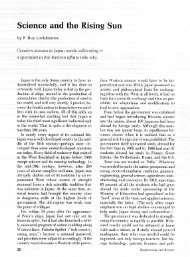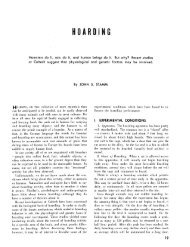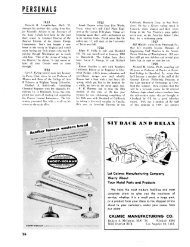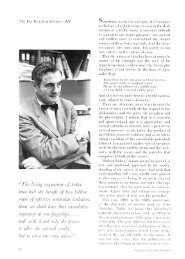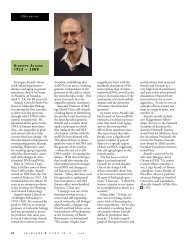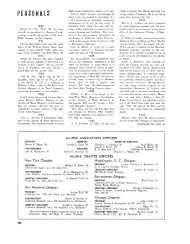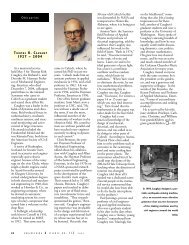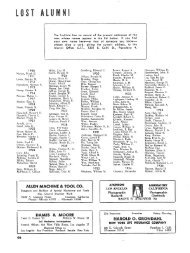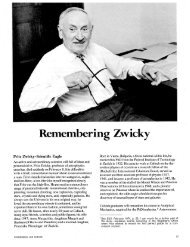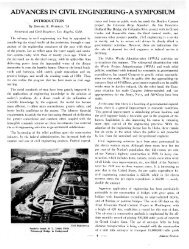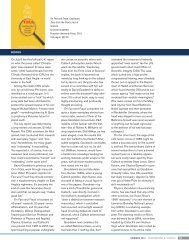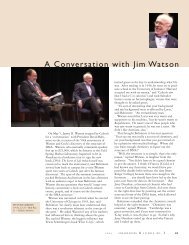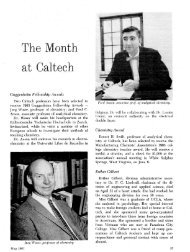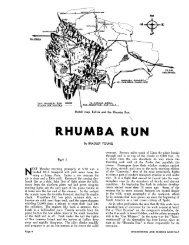published at the california institute of technology - Engineering ...
published at the california institute of technology - Engineering ...
published at the california institute of technology - Engineering ...
Create successful ePaper yourself
Turn your PDF publications into a flip-book with our unique Google optimized e-Paper software.
Additional W<strong>at</strong>er . . . continued<br />
w<strong>at</strong>er reclam<strong>at</strong>ion through ground-w<strong>at</strong>er recharge<br />
is <strong>the</strong> fact th<strong>at</strong> such w<strong>at</strong>er loses its identity and<br />
blends with n<strong>at</strong>ural ground w<strong>at</strong>er.<br />
Not all <strong>of</strong> <strong>the</strong> municipal and industrial waste wa-<br />
ters <strong>of</strong> <strong>the</strong> south coastal basin are amenable to rec-<br />
lam<strong>at</strong>ion by ground-w<strong>at</strong>er recharge. In some areas<br />
total dissolved solids are excessive because <strong>of</strong> brines<br />
from oil production or seaw<strong>at</strong>er infiltr<strong>at</strong>ion or <strong>the</strong><br />
regener<strong>at</strong>ion <strong>of</strong> ion-exchange resins. In o<strong>the</strong>r re-<br />
gions, industrial processes discharge chrom<strong>at</strong>es, bo-<br />
r<strong>at</strong>es, fluorides, and o<strong>the</strong>r minerals th<strong>at</strong> are difficult<br />
to remove by tre<strong>at</strong>ment processes and th<strong>at</strong> travel<br />
through <strong>the</strong> soil with little or no change.<br />
It has been estim<strong>at</strong>ed by <strong>the</strong> California Depart-<br />
ment <strong>of</strong> W<strong>at</strong>er Resources, and o<strong>the</strong>rs, th<strong>at</strong> about<br />
half <strong>of</strong> <strong>the</strong> present municipal waste w<strong>at</strong>er in <strong>the</strong><br />
south coastal basin is suitable in quality for recla-<br />
m<strong>at</strong>ion by ground-w<strong>at</strong>er recharge. Hence, <strong>the</strong> safe<br />
yearly yield <strong>of</strong> ground-w<strong>at</strong>er basins could be in-<br />
creased by about 0.6 <strong>of</strong> a cubic kilometer, based on<br />
<strong>the</strong> present w<strong>at</strong>er equ<strong>at</strong>ion. In <strong>the</strong> future, when <strong>the</strong><br />
full quota <strong>of</strong> nor<strong>the</strong>rn California w<strong>at</strong>er is being<br />
used, <strong>the</strong> total quantity <strong>of</strong> waste w<strong>at</strong>er may be ex-<br />
pected to increase to about 2.8 cubic kilometers, <strong>of</strong><br />
which about 60 percent, or 1.7 cubic kilometers<br />
could be reclaimed. This increment should be suf-<br />
ficient to meet sou<strong>the</strong>rn California's ultim<strong>at</strong>e w<strong>at</strong>er<br />
requirement.<br />
Wh<strong>at</strong> will it cost?<br />
How much will renov<strong>at</strong>ed w<strong>at</strong>er cost in compari-<br />
son with altern<strong>at</strong>ive sources <strong>of</strong> suppy? True cost fig-<br />
ures are difficult to ascertain, not so much for waste-<br />
w<strong>at</strong>er reclam<strong>at</strong>ion as for <strong>the</strong> present and planned<br />
future sources. True total cost figures include bond<br />
redemption over a reasonable period, interest on<br />
outstanding indebtedness <strong>at</strong> prevailing r<strong>at</strong>es, opera-<br />
tion and maintenance, power, and insurance. For<br />
any year, <strong>the</strong> actual cost <strong>of</strong> w<strong>at</strong>er is <strong>the</strong> total outlay<br />
for all expenses divided by <strong>the</strong> total volume <strong>of</strong> wa-<br />
ter produced. Digging out such figures is difficult<br />
indeed.<br />
I Estim<strong>at</strong>ed Total Costs for W<strong>at</strong>er I<br />
Source<br />
-<br />
Approxim<strong>at</strong>e Cost<br />
( 1 per 1,000 cubic meters )<br />
Local run-<strong>of</strong>f and ground w<strong>at</strong>er 3 - 10<br />
Owens Aqueduct 15 - 20<br />
Colorado River Aqueduct 28 - 45<br />
California W<strong>at</strong>er Plan 60 - 160<br />
Sea w<strong>at</strong>er demineraliz<strong>at</strong>ion 85 - 170<br />
Reclaimed w<strong>at</strong>er (including<br />
subsequent repumping) 20 - 30<br />
The price charged by <strong>the</strong> Metropolitan W<strong>at</strong>er<br />
District for Colorado River w<strong>at</strong>er is increasing. For<br />
<strong>the</strong> present fiscal year it varies from $13.80 per 1,000<br />
cubic meters for untre<strong>at</strong>ed w<strong>at</strong>er used for agriculture<br />
or replenishment, to $32.40 for s<strong>of</strong>tened and filtered<br />
w<strong>at</strong>er for municipal use. In addition, however,<br />
<strong>the</strong> Metropolitan W<strong>at</strong>er District receives revenue<br />
from taxes levied against member agencies. The<br />
true total cost is presently about $36 per 1,000 cubic<br />
meters, but it may vary between $28 and $45.<br />
To determine <strong>the</strong> true total cost <strong>of</strong> w<strong>at</strong>er from<br />
nor<strong>the</strong>rn California is almost impossible. Initially<br />
this w<strong>at</strong>er will probably cost in excess <strong>of</strong> $160 per<br />
1,000 cubic meters, but after deliveries approach<br />
<strong>the</strong> full capacity <strong>of</strong> <strong>the</strong> system, total costs may drop<br />
as low as $60.<br />
The demineraliz<strong>at</strong>ion <strong>of</strong> sea w<strong>at</strong>er in presently<br />
oper<strong>at</strong>ing plants costs in excess <strong>of</strong> $300 per 1,000<br />
cubic meters. A large plant proposed by <strong>the</strong> Metropolitan<br />
W<strong>at</strong>er District in conjunction with nuclear<br />
power production is expected to lower this cost to<br />
$57 <strong>at</strong> sea level or about $70 <strong>at</strong> <strong>the</strong> Diemer filtr<strong>at</strong>ion<br />
plant. These figures, however, are based on charging<br />
all possible costs against electric power production<br />
and amortiz<strong>at</strong>ion <strong>of</strong> capital costs <strong>at</strong> 3.5 percent<br />
interest for 30 years. With more equitable alloc<strong>at</strong>ion<br />
<strong>of</strong> costs, with realistic interest r<strong>at</strong>es, and with<br />
recognition th<strong>at</strong> mechanical equipment <strong>of</strong> this<br />
type will be obsolescent in 20 years or less, <strong>the</strong> true<br />
cost <strong>of</strong> demineraliz<strong>at</strong>ion will range from $85 to $170<br />
per 1,000 cubic meters.<br />
For waste-w<strong>at</strong>er reclam<strong>at</strong>ion, true total cost d<strong>at</strong>a<br />
are more realistic and better documented. Total<br />
costs <strong>at</strong> <strong>the</strong> Whittier Narrows W<strong>at</strong>er Reclam<strong>at</strong>ion<br />
Plant run about $12 per 1,000 cubic meters, and <strong>the</strong><br />
total cost <strong>of</strong> spreading for ground-w<strong>at</strong>er recharge is<br />
about $4. To this expense should be added about<br />
$4 for repumping into a w<strong>at</strong>er system, or a total<br />
<strong>of</strong> $20. Rendering Hyperion effluent suitable for<br />
ground-w<strong>at</strong>er injection is estim<strong>at</strong>ed <strong>at</strong> $20, to which<br />
$8 should be added for actual injection and subsequent<br />
repumping, or $28 per 1,000 cubic meters for<br />
<strong>the</strong> true total cost <strong>of</strong> this w<strong>at</strong>er supply.<br />
It is apparent, <strong>the</strong>refore, th<strong>at</strong> <strong>the</strong> true total cost<br />
<strong>of</strong> potable good-quality w<strong>at</strong>er reclaimed from waste<br />
w<strong>at</strong>er is slightly cheaper than Colorado River w<strong>at</strong>er<br />
and considerably less costly than nor<strong>the</strong>rn California<br />
or demineralized sea w<strong>at</strong>er. Moreover, with<br />
more than 25 percent <strong>of</strong> <strong>the</strong> imported w<strong>at</strong>er recoverable<br />
through ground-w<strong>at</strong>er recharging, sou<strong>the</strong>rn<br />
California's foreseeable w<strong>at</strong>er needs can be met<br />
with existing (including nor<strong>the</strong>rn ~difornia w<strong>at</strong>er)<br />
facilities.<br />
<strong>Engineering</strong> and Science



